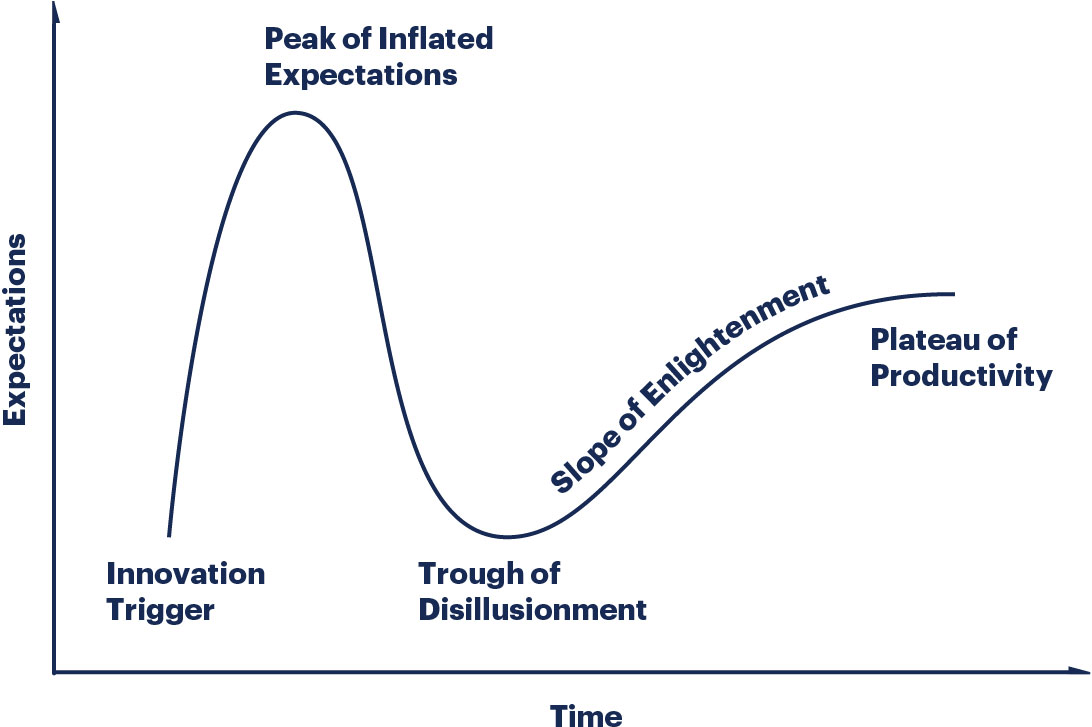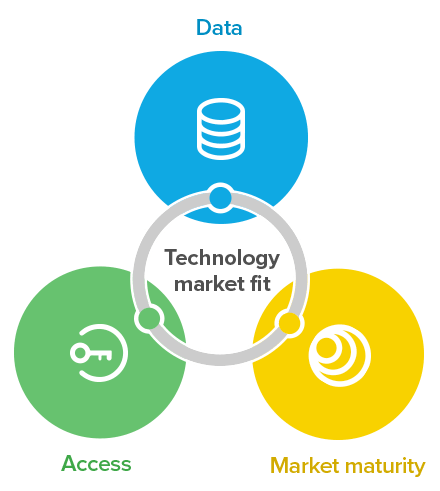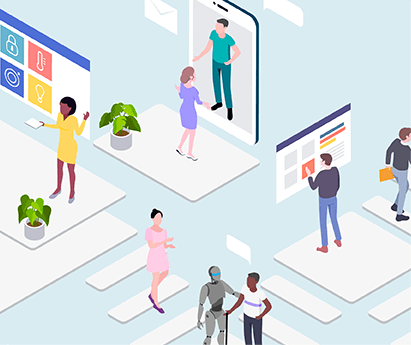Summary
- Technologies such as artificial intelligence (AI), machine learning (ML), and natural learning processing (NLP) can be used to solve business problems.
- With the increased prevalence of cloud computing and big data, IT management is now well positioned to step into business operations and make an impact.
- No longer solely about keeping the lights on, IT is vital to integrating data and privacy across the organization.
- ServiceDesk Plus is riding the technology wave with ML, AI, and NLP, as it enhances the customer experience and increases technician productivity.
Whenever someone talks about AI, ML, blockchain, NLP, and other technology trends, there's palpable excitement about the possibilities. In this article, we discuss these technology trends and their impact on IT management.

Before we dive into this year's IT trends, it's important to understand the difference between emerging technologies and technology trends. If you've been in any given industry for a couple of years, you'll know that technologies don't change much from one year to another. Technologies like AI and ML have existed for a long time and, as explained by Gartner's Hype Cycle, all technologies go through cycles.

So, when we talk about technology trends, we're not necessarily referring to new technologies per se, but rather we're talking about technologies that are seeing rapid adoption across an industry.
Technologies like AI have been around for decades
AI, ML, and blockchain have recently become buzz words in almost every industry. However, AI has been around for more than 60 years. So, why does it feel like it's only been around for a few years? Mostly because these technologies can now be used to solve day-to-day problems.

 In the last two decades, technology has really aged well. IT has its challenges; it has its problems. But what is fundamental has not changed. Twenty years ago you had technology, and you
had technology that enabled businesses. So businesses could basically try new business models and reach higher goals.
In the last two decades, technology has really aged well. IT has its challenges; it has its problems. But what is fundamental has not changed. Twenty years ago you had technology, and you
had technology that enabled businesses. So businesses could basically try new business models and reach higher goals.
- Rajesh Ganesan
AI and ML
Let's take a closer look at AI. AI feeds on data, and twenty years ago, we didn't have enough data to foster AI. Today, almost every interaction you have online is collected as a data point, and thanks to big data analysis, enormous data sets now can be processed in meaningful ways, providing insight into user behavior, processes, and outcomes.
Now, what if we fed this data into a program that can not only find patterns, but also learn from them?
It's important to keep in mind that ML wouldn't be possible if not for the ability to:
- Collect a huge amount of data (e.g., Internet of Things, access to a multitude of different channels, data traceability).
- Store data (cost of data storage has reduced over the years).
- Train and test data (cheap computing power).
- Find an use for the technology (relevant business problem to solve).
If we were to extrapolate the "product-market" fit theory by Silicon Valley venture-capitalist Marc Andreessen to this context, we realize that the technologies don't trend unless there's a conducive environment (market) that enables them to mature into practical applications; put differently, there needs to be a "technology-market" fit. To find the right market fit, we've identified three important factors to consider:
- Data. The ability to collect, store, and process data at a reasonable cost. On one hand, businesses have huge amounts of data, and they're always looking to improve the efficiency of their systems. On the other hand, technologies like AI, ML, IoT, and predictive analytics also rely on data to achieve their true potential. On principle, data is the currency through which enterprises and technologies form a symbiotic relationship.
- Access. The ability to access technology from any place, at any time, and through any channel. Initially, enterprise software was difficult to purchase, not only because it involved a long sales cycle, but also because it required an expensive sales force. The internet has single-handedly reduced dependence on a heavy-duty sales force, effectively democratizing enterprise software. As a result, many companies can deliver their services over the internet at a fraction of the cost, and in turn, many growing businesses have affordable access to services which previously were inaccessible.
- Market maturity. Even the most advanced technology is useless if end users find it difficult to use. For a long time, enterprise software was focused on outcomes or utility, as opposed to user experience. However, with the consumerization of technology, businesses now have the opportunity to provide an integrated experience, using technologies like chatbots and voice assistants to open up new channels of delivering services while enhancing the user experience.

It goes without saying that any given technology needs to find a market (conducive environment) fit. For better understanding, let's take a few examples and break them down. Consider ML and its application in two separate cases: for image recognition as a part of building autonomous vehicles and for proactive monitoring in an IT infrastructure. In both these cases, ML has found a market fit.
 Technology:
Machine learning |
Application one : Image recognition in autonomous cars |
Application two : Proactive detection of network failures |
 Data
|
Image of cars, people, and objects |
Network status logs |
|
Market maturity
|
People are exposed to autonomous functioning of cars at a very basic level (cruise control) |
Technicians are used to manually monitoring the system status using various applications |
With that as a basis, let's see how business can make use of the technology-market fit to solve their business problems. Typically in an organization, this task defaults to the IT department and CIO, simply because they have the expertise for technology that they've built over the years.
For a long time, IT was considered a backroom operation that was merely keeping the lights on, but that's changing. From managing operations to impacting outcomes, the role of IT is moving up the value chain.

Twenty years ago, the technology options were limited, and you were serving customers who were not really exposed to technology. Now that's all changed. How well you leverage technology matters.
- Rajesh Ganesan
IT continues to lead the journey from legacy internal servers to cloud-based computing, storage, and memory. This movement has provided businesses with the velocity they need to scale while ensuring high availability. That means IT is now in a better position to set foot into the day-to-day of business operations.
IT has the time and resources to reinforce the technology culture (read: digital transformation) by providing insights into tools, data, and processes. In fact, many businesses are already seeing signs of digital transformation impacting business operations, so much so that many corporate-level decisions are driven by insights from initiatives fueled by big data, analytics, and AI.

 IT's value is going to go up because IT personnel not only have to understand how to enable technologies, but they also must understand the implications of how best to deliver technology
holistically. The times are only going to get a lot more interesting and challenging.
IT's value is going to go up because IT personnel not only have to understand how to enable technologies, but they also must understand the implications of how best to deliver technology
holistically. The times are only going to get a lot more interesting and challenging.
- Rajesh Ganesan
IT's role doesn't stop with leading digital transformation. In fact, after the recent surge of data privacy regulations, businesses are starting to value the importance of IT even more.
Integrating information security with digital initiatives
With the rapid consumerization of technology, data proliferation is inevitable. A typical end user runs several applications every day at work, and according to a report from Symantec CloudSOC, the average enterprise uses 928 cloud apps.
According to a 2017 report from Kleiner Perkins, about 94 percent of all cloud apps have serious security and compliance implications and aren't enterprise-ready. As an industry, we're starting to realize the need for information security, and regulations like the GDPR are making businesses take a thorough look at data privacy measures.

At home, we are using the same internet-enabled devices [that we use at work]. Where IT can actually make a difference is understanding what is happening behind the scenes in terms of security, uptime, the regulations they have to comply (with), and making sure insiders are not abusing such systems.
- Rajesh Ganesan
With such a strong foothold in information security, IT can now step up and ensure that security measures are put in place, not only for the infrastructure initiatives, but also within technology/digital initiatives across business operations. Additionally, with new data protection regulations like the California Consumer Privacy Act (CCPA) and ePrivacy on the way, IT is particularly well positioned to help businesses comply with legal standards; the IT team can help the legal team with compliance audits while fostering a culture of data privacy throughout the entire business.
Taking a sneak peek into the future what's 2019 going to be like for ManageEngine?
Until now, we've discussed technology trends and the changing role of IT. But we need to practice what we preach. Most of the feature enhancements in ServiceDesk Plus are made based on what we just discussed: identifying technology-market fits (i.e., practical use cases) and embracing the changing role of IT by rolling out GDPR-related features to address data protection. "For me, I see chatbot(s) as a different form of user interface. UIs have been evolving over the [...] last two to three decades. I see bots as one form of that evolution. But it enables a lot of interesting use cases. How do you put these things together? When I'm driving back from work, a notification can come and dictate a task to me that I can immediately take care of (using voice commands) without taking my hands off the wheel. I can just issue a command that can do my job immediately. And we understand the technology possibilities and what the users want, and that's exactly what we are building in 2019 and going forward." said Rajesh Ganesan.
The last year has been a vast playing ground for us, as we explored and enhanced various emerging technologies, such as AI, ML, NLP, and chatbots. In 2019, we hope to build on the expertise we've gained over the past year in order to solve more of the IT problems our customers face.
Some of the practical applications for these technologies in IT management include:
- AIOps for proactive monitoring
- Predictive analytics that help spot anomalies
- Chatbots that will lessen the burden on L1 teams
- Recommendation engines for IT operations ITSM, monitoring, etc.
- Auto-detection of data misuse
Well, that's all we have for now. Now we'd like to hear your thoughts on the topic. Join the discussion #techtrends @manageengine.







